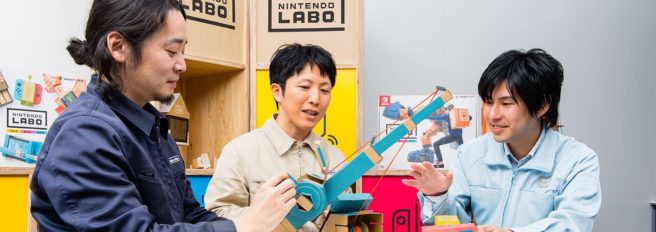Big Nintendo Labo interview – origins, challenges, changes along the way, much more
Physical feedback
When you hold a Toy-Con creation, it clearly feels different than other game controllers, and there’s a feeling of feedback from it. Was this something you intentionally sought to create?
Mr. Sakaguchi: We call it “physical feedback.” The Toy-Con Motorbike accelerator really shows it off.
Mr. Ogasawara: It’s made with rubber bands so that more force is required the further you try to twist it.
Mr. Sakaguchi: Had we tried this with controllers we’ve made before, like the Wii Remote, you’d twist it through the empty air and not feel anything. But if this is supposed to be the handle, then you want the shift lever to be here too, right? And if this is supposed to be a motorbike, you want to feel the acceleration in your hands.
It’s great how the handlebars and brake return to their starting point after the player moves them.
Mr. Sakaguchi: I don’t think I’m the only one that wants physical feedback in their hands. It’s much more immersive than waving something in the air. With Nintendo Labo, we were finally able to build that physical feedback into the system.
By adding constraints to the two Joy-Con, by making it so that they can only move in certain directions, it’s very easy to get that value from them. The restriction of movement makes it so the input values are limited – in a good way. If you make the controller shaped like a Fishing Rod then it can only be held like a fishing rod, so consumers will intuitively understand the correct way to hold it. I’d run into this kind of problem before.
I remember when we were developing Splatoon. We had the opportunity to show what we’d been working on to people outside of the development team, and we instructed players holding the Wii U GamePad to “tilt to the right.” As it turns out, everyone had their own interpretation of what we meant. I particularly remember one person that just slowly craned their neck to the right…
That caught me off guard, but it drove the point home that once these products are out in the world, there might be a lot of people with differing ideas of how to use them, of how they were intended to be used. The possibility for variance there is a scary thing. Once it’s out of our hands we can’t see how customers are playing with it, you know?
That must be intimidating for a developer.
Mr. Sakaguchi: Oh, it’s terrifying.
First, we have the cost of explaining how it works to the user, the “study cost,” if you will. If we can’t get the user past that, they can’t play any games at all. So we want the explanatory matter to be as short and simple as possible. We focused on this a lot while developing Nintendo Labo, and we realized that to make something easy to understand it had to be immediately clear how it was held, and how it was supposed to move.
I see. That makes sense.
Mr. Ogasawara: And yet…You know the antenna we attach to the Nintendo Switch as part of the Toy-Con RC Car?
Yes, it’s there on the top.
Mr. Sakaguchi: It actually doesn’t serve any function at all.
We tried to get rid of everything that doesn’t serve a function, and spent a long time removing unnecessary parts. But this antenna, it doesn’t do anything. We just like it. (Laughs.)
But it feels so different with the antenna on there!
Mr. Sakaguchi: I think so too, and we realized that we had to rethink what we meant by “serving a function. ”
You don’t have to explain what it is. You know it’s an RC Car just by looking at it.
Mr. Kawamoto: I’ve been wondering about the Toy-Con Fishing Rod. Why did you make it so the reel clicks when you wind it?
Mr. Sakaguchi and Mr. Ogasawara: Don’t you think it’s better with the clicking? (Laughs.)
Mr. Sakaguchi: But seriously, we did it because the sound is different depending on the direction you wind it. It just kind of worked out that way. (Laughs.)
And this part here (top of the Fishing Rod) doesn’t really need to extend.
It feels very different if the Toy-Con Fishing Rod makes a sound, and fishing poles feel like they should be extendable. (Laughs.) And the piano keys bounce back to the starting position after you hit them, don’t they?
Mr. Kawamoto: That’s right. Right from the start of development we were really concerned with the weight of the keystroke. It had to feel right. It’s really at the core of what Nintendo Labo is all about. We intentionally set out to make experiences that weren’t possible with a standard game controller – I think that was what really guided the development process.
Mr. Sakaguchi and Mr. Ogasawara: We feel the same way.
